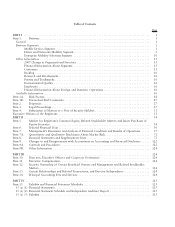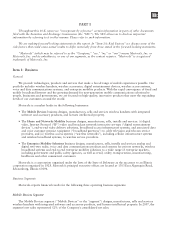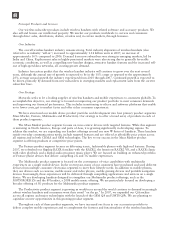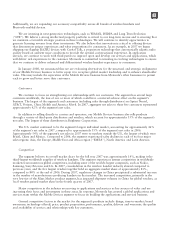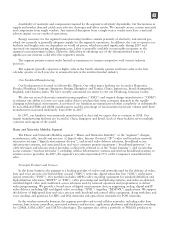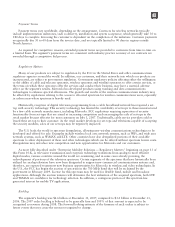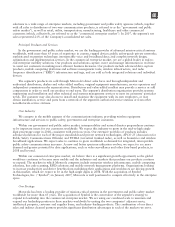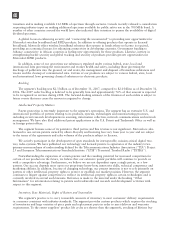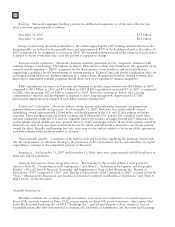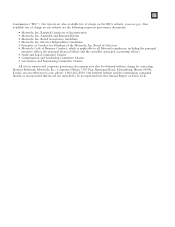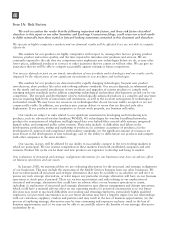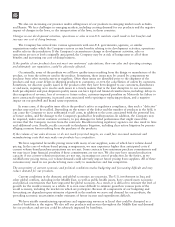Motorola 2007 Annual Report Download - page 18
Download and view the complete annual report
Please find page 18 of the 2007 Motorola annual report below. You can navigate through the pages in the report by either clicking on the pages listed below, or by using the keyword search tool below to find specific information within the annual report.
Intellectual Property Matters
Patent protection is extremely important to the segment’s operations. The segment has an extensive portfolio
of patents relating to its products, systems, technologies and manufacturing processes.
The segment seeks to build upon our core enabling technologies, such as digital compression, encryption and
conditional access systems, and wireless air-interface technology in order to lead worldwide growth in the market
for wired and wireless communications networks. Our policy is to protect our proprietary position by, among
other methods, filing U.S. and foreign patent applications to protect technology and improvements that we
consider important to the development of our business. We also rely on our proprietary knowledge and ongoing
technological innovation to develop and maintain our competitive position, and will periodically seek to include
our proprietary technologies in certain patent pools that support the implementation of standards. We are a
founder of MPEG LA, the patent licensing authority established to foster broad deployment of MPEG-2 compliant
systems. In addition, we have licensed our digital conditional access technology, DigiCipher
»
II, to other equipment
suppliers and have formed joint ventures with Comcast for development and licensing of conditional access
technology.
We also enter into other license agreements, both as licensor and licensee, covering certain products and
processes with various companies. These license agreements require the payment of certain royalties that are not
expected to be material to the segment’s financial results. Royalty and licensing fees vary from year to year and are
subject to the terms of the agreements and sales volumes of the products subject to licenses. Reference is made to
the material under the heading “Other Information” for information relating to patents and trademarks and
research and development activities with respect to this segment.
Inventory, Raw Materials, Right of Return and Seasonality
The segment’s practice is to carry reasonable amounts of inventory in order to meet customer delivery
requirements in a manner consistent with industry standards. At the end of 2007, the segment had lower inventory
balances than at the end of 2006, primarily due to the completion of significant project milestones and the sale of
the embedded communications computing business.
Availability of materials and components required by the segment is relatively dependable, but fluctuations in
supply and market demand could cause selective shortages and affect results. We currently source certain materials
and components from single vendors. Any material disruption from a single-source vendor may have a material
adverse impact on our results of operations.
Natural gas, electricity, and, to a lesser extent, oil are the primary sources of energy required for our
manufacturing operations, which are currently in generally adequate supply for the segments operations. In
addition, the cost to operate our facilities and freight costs are dependent on world oil prices, which increased
significantly during 2007 and increased our manufacturing and shipping costs. Labor is generally available in
reasonable proximity to the segment’s manufacturing facilities. However, difficulties in obtaining any of the
aforementioned items or a significant cost increase could affect the segment’s results.
Generally, we do not permit customers to return products, other than under standard warranty provisions.
The segment has not experienced seasonal buying patterns for its products.
Our Facilities/Manufacturing
Our headquarters is located in Horsham, Pennsylvania. Major design, integration, manufacturing and
distribution centers are located in: Arlington Heights and Schaumburg, Illinois; Chandler, Arizona; Fort Worth,
Texas; Taipei, Taiwan; Nogales, Mexico; Bangalore, India; Swindon, England; Hangzhou and Tianjin, China; and
Penang, Malaysia. In addition to our own manufacturing, we utilize non-affiliated electronics manufacturing
suppliers and original design manufacturers, primarily in Asia, in order to enhance our ability to lower costs and/
or deliver products that meet consumer demands.
Enterprise Mobility Solutions Segment
The Enterprise Mobility Solutions segment (“Enterprise Mobility Solutions” or the “segment”) designs,
manufactures, sells, installs and services analog and digital two-way radio, voice and data communications
products and systems for private networks, wireless broadband systems and end-to-end enterprise mobility
10


